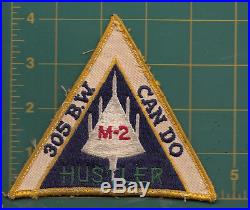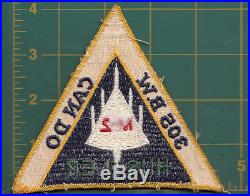


Bunker Hill (Grissom) Air Force Base operations. In May 1959, the 305th Bomb Wing (with B-47s) was reassigned to Bunker Hill Air Force Base. Indiana and assumed responsibility for operating the base. Later that same year, the first Boeing KC-135A Stratotankers. Were assigned to the unit, replacing the propeller-driven KC-97s that had difficulties keeping up with the B-47 jet aircraft. With the first aircraft received on 11 May 1961. Two months later, the first TB-58A trainer arrived. Three squadrons (364th, 365th and 366th) were equipped with B-58As, and, the wing was declared operationally ready in August 1962. A wing B-58 set five records on 16 October 1963 by flying from Tokyo. In a little-known attempt to increase the flexibility of the B-58 as a weapons system, experiments were carried out in April 1964 under a program known as Operation Bullseye to see if the B-58 could carry and deliver conventional bombs. In coordination with Republic F-105Ds. Sorties were flown using B-58s as lead ships and pathfinders and as independent strike aircraft. It was demonstrated that the B-58 could carry iron bombs on the wing root bomb racks that had earlier been added to accommodate four Mk. Iron bombs of varying weights up to 3.000 pounds were dropped, usually from low altitudes and at speeds of 600 knots. Almost all of the drops were visual, with the AN/ASQ-42 system rarely being used. The wing operated a B-58 combat crew training school (CCTS), August 1965 December 1969, and gained a Boeing EC-135. Post-Attack Command Control System (PACCS) mission with the 3d PACCS Squadron in mid-1966. After 26 years of bearing the name Bunker Hill , the base was renamed Grissom Air Force Base on 12 May 1968 after Lieutenant Colonel Virgil I. USAF, a native of Mitchell, Indiana, who was one of the original seven Mercury astronauts. Having later commanded the Gemini 3 mission in 1965, Lieutenant Colonel Grissom was assigned as commander for the first manned Apollo mission, but was killed with the rest of his crew during a fire in his Apollo 1. Capsule during a pre-launch rehearsal on Pad 34 at Cape Kennedy, Florida. The active service life of the B-58 was destined to be rather short. Phaseout of the B-58 fleet was ordered by Secretary of Defense. In December 1965, since it was felt that the high-altitude performance of the B-58 could no longer guarantee success against increasingly sophisticated Soviet air defenses, particularly high-altitude surface-to-air missiles such as the SA-2 Guideline. At that time, Secretary McNamara also announced that the F-111. Would be built for both the U. Air Force and U. McNamara further proposed that a SAC variant of the new F-111, to be designated FB-111A, along with improvements in the Air Force Minuteman. Missile systems and modernization of the subsonic Boeing B-52. Would enhance strategic deterrence and make the B-58 superfluous to the needs of the USAF. The first B-58 to go into long-term storage was B-58A AF Serial No. 59-2446 which flew to Davis-Monthan Air Force Base. Arizona on 5 November 1969. Once underway, the B-58 retirement program moved relatively rapidly. The retirement was completed on 16 January 1970, when the 305th Bomb Wing’s last two B-58s AF Serial No. 55-0662 and 61-078 were flown to Davis-Monthan for storage. The item “Authentic Air Force USAF B-58 MACH 2 305th Bomb Wing (M) Bunker Hill AFB” is in sale since Tuesday, March 14, 2017. This item is in the category “Collectibles\Militaria\Vietnam (1961-75)\Original Period Items\Patches”. The seller is “zeustinker” and is located in Marietta, Georgia. This item can be shipped worldwide.
